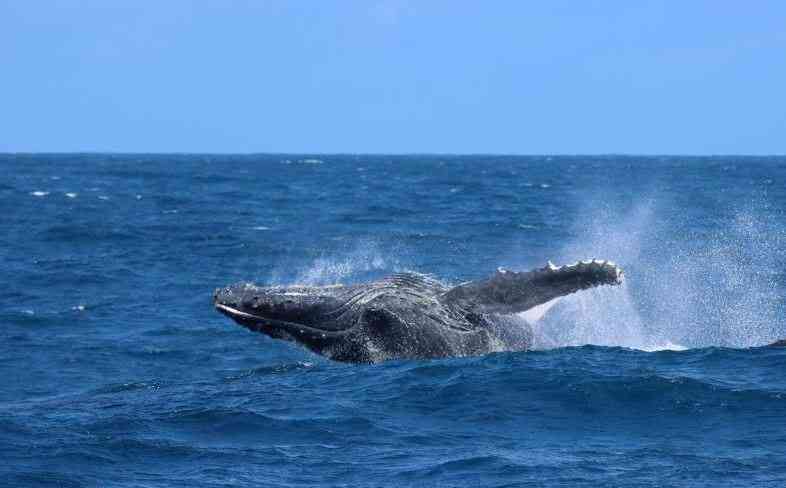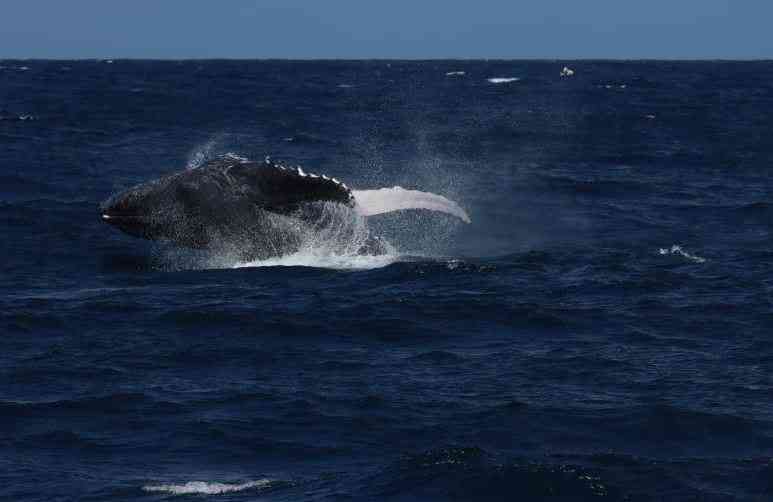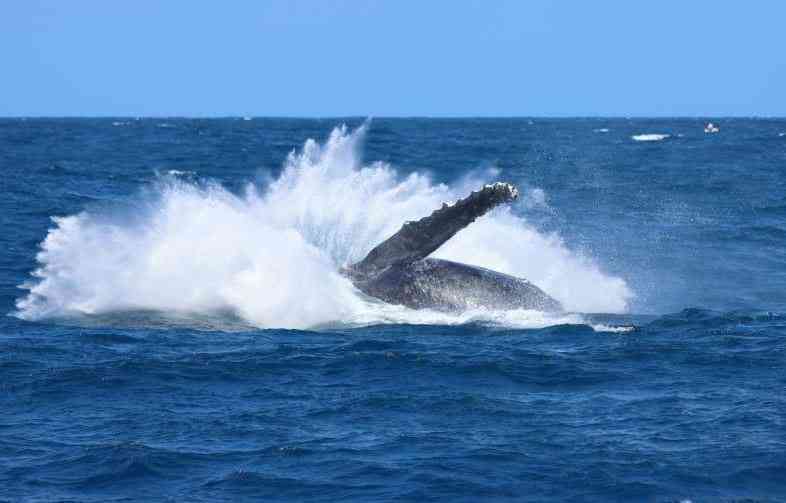
Whale watching in Watamu. (Courtesy, Watamu Marine Association)
Watamu, the idyllic enclave along Kenya's north coast is one of the country's top tourism hotspots. There are several 'must do' activities here, enough to satisfy everyone's fancies.
Fishing enthusiasts will find Watamu's waters the ideal environment for big game fishing. For years, local and international anglers have outdone each other as they sought to tag and release any of the marine's Big Five-the blue marlin, black marlin, striped marlin, sailfish, and swordfish.
History lovers will find solace in exploring the inner sanctums of ancient ruins at Gede, remnants of a once thriving city that seemed to have been abandoned in a hurry. In the nearby Arabuko Sokoke Forest, the fresh breeze compensates for the humid coastal environment. Here, be on the lookout for the rare elephant shrew.
Those intent on rekindling their romantic spark will find no better way than to spend the evening riding a traditional dhow around Mida Creek, gazing over the horizon at the setting sun with a glass of champagne in hand.
All these are year-round activities. But Watamu is currently the theatre of yet another act-the annual whale migration. As the name suggests, hundreds of humpback whales are currently roaming the waters around Watamu as much as the wildebeests are thumping their hooves in Masai Mara.
In early June of each year, these behemoths are sighted in the warm waters of the east African coast where they spend quality time after escaping from the colder waters of Antarctica. They have one of the longest migrations of any animal in the world.
Mara has wildebeests, Watamu has whales
Like the wildebeests, the whales currently thrilling guests in Watamu migrate for a number of reasons, topmost among these being the need to find prospective mates and to give birth. And what a better place to accomplish both missions than in the shallow, warm waters near the offshore reef system of the Indian Ocean.

. (Courtesy, Watamu Marine Association)
For a creature 15 metres long and weighing close to 30 tonnes, or six times the weight of an elephant, the 4,000-kilometre journey is worth it!
Whales may have lived in the shadows of their smaller cousins, the dolphins, known for their acrobatic, synchronized stunts. Whales too can show off, and in a big way, and humpbacks, according to scientists, are the most active of all whales. Despite their massive sizes, leaping out of water presents little challenge. Whale watchers have been mesmerized as these creatures jump out of the water, slapping the surface with their pectoral fins or tails in a well-choreographed act known as breaching.
In Watamu, the proliferation of what a local marine association terms "competitive mating behaviour involving posturing males and females" has attracted watchers both on land and in the sea.
Among them is Mike Mwang'ombe, a whale enthusiast and manager of Watamu Marine Association's Marine Mammal Conservation and Research Program. Mike has spent over a decade studying their peculiar habits through Watamu Marine Association. Joined by a coalition of fishermen, tourist boats, scientists, and students, Mike has cast his eyes to the ocean to report not just on whales but also dolphins and dugongs in Kenya. His organization has worked with Kenya Wildlife Service and a citizen science group, Kenya Marine Mammal Network in conserving marine mammals and help to grow the dolphin and whale watching ecotourism at Kenya's coast.

"Watamu is recognised globally as an IUCN Important Marine Mammal Area, assisted by the information provided by the citizen scientists," he says.
"Every year we learn something new, and this year the male whales are arriving in larger groups of up to 12. Male whales (sometimes with a female in their midst) vie for position, using their unique techniques to make themselves more attractive to the opposite sex."
This, says Mike, can be observed in a variety of ways from the gentle creation of vocalisations or 'whale song', to synchronized breaching, tail slapping, fin waving and even body slamming.
Even the local marine caretakers at KWS were drawn into the spectacle. "Which winning male whale jumped (breached) the highest to get his female?" KWS asked on its Facebook page. "Male whales have been competing for female attention all week, and activity levels reached a peak yesterday with over eight whales performing quadruple breaches simultaneously, tail lobbing, pectoral fin slapping, and spy hopping."

Naming the giants
Like the elephants of Amboseli that have individual names, KWS has decided to name some of the whales. In yet another post, KWS uploaded a short video of a mother and calf in a showy display off the coast of Watamu.
The mother's name was given as Naimah, of ID number, WT01_072922 and she was having an intimate moment with her calf, Dayo.
But how one can manage to identify and name a creature that only surfaces for a few fleeting seconds at a time. While KWS did not provide details of how they managed what seems to be an impossible task, experts say there are distinct details that can help tell one whale from another.
According to Whale Sense, a voluntary education and recognition program for commercial whale watching companies in the United States and sponsored by the National Oceanic and Atmospheric Administration, individual whales have distinct markings akin to your fingerprints, thus no two whales are alike. But patience is needed to identify such features.
"Take photos. Lots of photos," the marine body says. Such photos, it adds, assist scientists in locating unique features such as tags, scars, and other natural marks. One of the most commonly used features is the whale's tail or fluke. In a nose-dive back into the water after plunging its body upwards, a humpback whale reveals distinct white and black pigment patterns, scars that taken together form a unique identity. By October, the show will be at the tail end, and the mighty creatures will head back south for a sumptuous meal of krill.
 The Standard Group Plc is a multi-media organization with investments in media
platforms spanning newspaper print
operations, television, radio broadcasting, digital and online services. The
Standard Group is recognized as a
leading multi-media house in Kenya with a key influence in matters of national and
international interest.
The Standard Group Plc is a multi-media organization with investments in media
platforms spanning newspaper print
operations, television, radio broadcasting, digital and online services. The
Standard Group is recognized as a
leading multi-media house in Kenya with a key influence in matters of national and
international interest.

